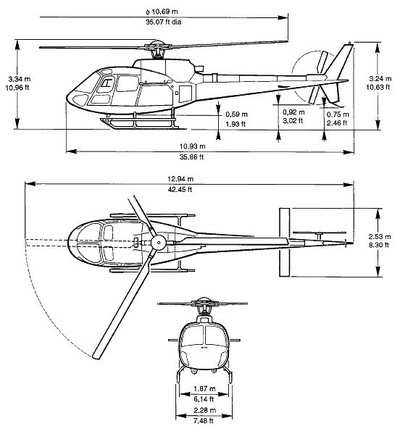Tue, Sep 30, 2008
Hydraulic Failures Can Lead To Controllability Issues
 Citing six events involving Eurocopter AS350 helicopters in the
past six years -- including two fatal crashes -- on Tuesday the
National Transportation Safety Administration issued
recommendations to the Federal Aviation Administration and European
Aviation Safety Agency to address concerns over the helicopter's
hydraulic pump drive shafts.
Citing six events involving Eurocopter AS350 helicopters in the
past six years -- including two fatal crashes -- on Tuesday the
National Transportation Safety Administration issued
recommendations to the Federal Aviation Administration and European
Aviation Safety Agency to address concerns over the helicopter's
hydraulic pump drive shafts.
Those shafts are also used in smaller EC130, the NTSB noted.
The Board recommended the FAA:
- Require Eurocopter to identify AS-350 and EC-130 helicopter
hydraulic pump drive shafts and coupling sleeves with splines that
do not meet design specifications and take appropriate action to
ensure that these parts (that is, replacement parts and parts to be
installed in new helicopters) are expeditiously removed from the
supply chain. (A-08-75)
- Require operators of Eurocopter AS-350 and EC-130 helicopters
to perform a wear check, visual inspection, and lubrication of the
hydraulic power assembly splines and coupling sleeve splines in
accordance with the latest version of the maintenance manual at the
earliest opportunity, and, thereafter, require operators to repeat
the wear check, visual inspection, and lubrication of the splined
connection at 100-hour intervals, and remove unairworthy parts from
service. (A-08-76)
The same recommendations were also made to EASA, under A-08-77
and A-08-78, respectively.
"The Safety Board Materials Laboratory examined parts of the
helicopters involved in these events, specifically the hydraulic
pump assembly and pulley assembly that provide all the hydraulic
power for the main rotor controls and the tail rotor controls," the
NTSB notes. "Staff found that the splined connection that couples
the hydraulic pump to its pulley assembly displayed excessive wear
that in some cases caused it to fail with subsequent loss of
hydraulic power. Loss of hydraulic power hinders helicopter control
and increases the possibility of a serious accident...

"The helicopter can be flown without hydraulic power (that is,
in manual mode) but doing so increases the physical demands on the
pilot and can cause a serious accident if the pilot has not
maintained familiarity with operation of the helicopter in manual
mode or if an uncommanded reversion to manual mode occurs suddenly,
especially during a critical maneuver."
FMI: Read The NTSB Recommendations Here And Here
(.pdf)
More News
Aero Linx: Florida Antique Biplane Association "Biplanes.....outrageous fun since 1903." That quote really defines what the Florida Antique Biplane Association (FABA) is all about.>[...]
Beyond Visual Line Of Sight (BVLOS) The operation of a UAS beyond the visual capability of the flight crew members (i.e., remote pilot in command [RPIC], the person manipulating th>[...]
Also: ForeFlight Upgrades, Cicare USA, Vittorazi Engines, EarthX We have a number of late-breaking news highlights from the 2024 Innovation Preview... which was PACKED with real ne>[...]
“For Montaer Aircraft it is a very prudent move to incorporate such reliable institution as Ocala Aviation, with the background of decades in training experience and aviation>[...]
Maximum Authorized Altitude A published altitude representing the maximum usable altitude or flight level for an airspace structure or route segment. It is the highest altitude on >[...]
 ANN's Daily Aero-Linx (04.13.24)
ANN's Daily Aero-Linx (04.13.24) ANN's Daily Aero-Term (04.13.24): Beyond Visual Line Of Sight (BVLOS)
ANN's Daily Aero-Term (04.13.24): Beyond Visual Line Of Sight (BVLOS) Airborne 04.09.24: SnF24!, Piper-DeltaHawk!, Fisher Update, Junkers
Airborne 04.09.24: SnF24!, Piper-DeltaHawk!, Fisher Update, Junkers Aero-News: Quote of the Day (04.14.24)
Aero-News: Quote of the Day (04.14.24) ANN's Daily Aero-Term (04.14.24): Maximum Authorized Altitude
ANN's Daily Aero-Term (04.14.24): Maximum Authorized Altitude




